Info
(Gmelin, 1789)
Johnny Jensen photographed this originally tropical pufferfish and made the picture available to the marine encyclopedia.
The second picture was taken by J.E. Randall from Honolulu, Hawaii.
With a considerable size of up to 110 cm and 7 kilograms, the animal is definitely too large for home aquariums, but can be found in large display aquariums.
Formerly only found in the tropics, the fish can now also be found in the Red Sea and the Mediterranean, which is known as Lessepsian migration.
The animal is found in offshore reefs at depths of 18 - 100 meters.
The skin and internal organs of pufferfish are highly poisonous (tetrodotoxin) and the animal has very strong teeth, which it uses to inflict severe bite wounds on unwary divers and anglers who have been hooked by the animal.
Synonyms:
Fugu sceleratus (Gmelin, 1789)
Gastrophysis sceleratus (Gmelin, 1789) (misspelling)
Gastrophysus sceleratus (Gmelin, 1789)
Gastrophysus scleratus (Gmelin, 1789) (misspelling)
Lagocephalus scleratus (Gmelin, 1789) (misspelling)
Lagocephalus scleratus Gmelin, 1789 (misspelling)
Pleudranacanthus sceleratus (Gmelin, 1789) (misspelling)
Pleuranacanthus sceleratus (Gmelin, 1789)
Spheroides sceleratus (Gmelin, 1789) (misspelling)
Sphoeroides sceleratus (Gmelin, 1789)
Sphoeroides scleratus (Gmelin, 1789) (misspelling)
Tetraodon bicolor Brevoort, 1856
Tetraodon blochii Castelnau, 1861
Tetraodon sceleratus Gmelin, 1789 (synonym)
Tetrodon sceleratus Gmelin, 1789 (misspelling)
Puffer fish can produce toxins such as tetrodotoxin and saxitoxin and accumulate them in the skin, gonads and liver.
The toxin tetrodotoxin, which is contained in the fugu, is 1000 times more toxic than cyanide and there is no antidote serum, death then occurs by respiratory paralysis
The degree of toxicity varies depending on the species, but also on the geographical area and season.
We recommend that you never prepare puffer fish yourself, as the risk of fatal poisoning is far too great.
If you still absolutely want to eat puffer fish meat (fugu), then the fish should only be slaughtered by a Japanese special chef with a license and several years of training.
Only the training of these special chefs can guarantee the correct slaughter, complete removal and proper disposal of all toxic parts of the fish.
Johnny Jensen photographed this originally tropical pufferfish and made the picture available to the marine encyclopedia.
The second picture was taken by J.E. Randall from Honolulu, Hawaii.
With a considerable size of up to 110 cm and 7 kilograms, the animal is definitely too large for home aquariums, but can be found in large display aquariums.
Formerly only found in the tropics, the fish can now also be found in the Red Sea and the Mediterranean, which is known as Lessepsian migration.
The animal is found in offshore reefs at depths of 18 - 100 meters.
The skin and internal organs of pufferfish are highly poisonous (tetrodotoxin) and the animal has very strong teeth, which it uses to inflict severe bite wounds on unwary divers and anglers who have been hooked by the animal.
Synonyms:
Fugu sceleratus (Gmelin, 1789)
Gastrophysis sceleratus (Gmelin, 1789) (misspelling)
Gastrophysus sceleratus (Gmelin, 1789)
Gastrophysus scleratus (Gmelin, 1789) (misspelling)
Lagocephalus scleratus (Gmelin, 1789) (misspelling)
Lagocephalus scleratus Gmelin, 1789 (misspelling)
Pleudranacanthus sceleratus (Gmelin, 1789) (misspelling)
Pleuranacanthus sceleratus (Gmelin, 1789)
Spheroides sceleratus (Gmelin, 1789) (misspelling)
Sphoeroides sceleratus (Gmelin, 1789)
Sphoeroides scleratus (Gmelin, 1789) (misspelling)
Tetraodon bicolor Brevoort, 1856
Tetraodon blochii Castelnau, 1861
Tetraodon sceleratus Gmelin, 1789 (synonym)
Tetrodon sceleratus Gmelin, 1789 (misspelling)
Puffer fish can produce toxins such as tetrodotoxin and saxitoxin and accumulate them in the skin, gonads and liver.
The toxin tetrodotoxin, which is contained in the fugu, is 1000 times more toxic than cyanide and there is no antidote serum, death then occurs by respiratory paralysis
The degree of toxicity varies depending on the species, but also on the geographical area and season.
We recommend that you never prepare puffer fish yourself, as the risk of fatal poisoning is far too great.
If you still absolutely want to eat puffer fish meat (fugu), then the fish should only be slaughtered by a Japanese special chef with a license and several years of training.
Only the training of these special chefs can guarantee the correct slaughter, complete removal and proper disposal of all toxic parts of the fish.







 Rafi Amar, Israel
Rafi Amar, Israel









